French Crown Jewels Louvre Museum
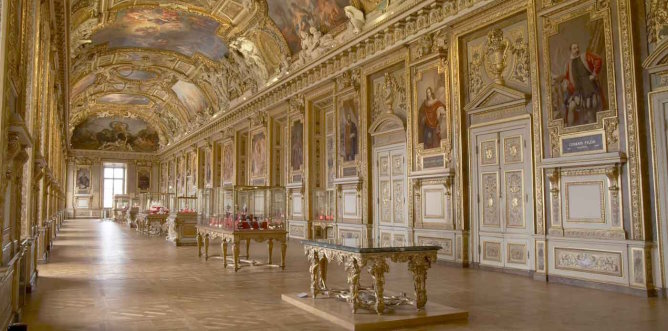
The Louvre Museum exhibits a unique collection of French Crown Jewels in Gallery d'Appolon on level 1 of the Denon wing. From the crown of Louis XV to the Le Régent diamond of 140 carats and the crown of Empress Eugénie, the collection shows the fever of the monarchs to collect gems and make jewels of goldsmithery. Louvre Museum.
Sunday October 20 2025 French Crown Jewels burglary
A spectacular burglary took place on Sunday morning, October 20, 2025, shortly after the Louvre opened, when a commando of four criminals stole eight priceless 19th-century jewels before fleeing. Around 9:30 a.m., after the museum had opened its doors to the public half an hour earlier, four suspects arrived on Quai François Mitterrand. Two of them were spotted aboard a forklift, one wearing a yellow vest and the other an orange vest, and the other two were aboard two T-Max scooters. Using traffic cones, they secured the area around their break-in before deploying a forklift to access the first floor, directly into the Apollon Gallery, via a window they smashed with an angle grinder. Once inside the museum, the suspects smashed two display cases and stole eight jewels.
Among the jewels were the necklace from the sapphire parure of Queen Marie-Amélie and Queen Hortense, composed of eight sapphires and 631 diamonds, and Empress Eugénie's tiara, which contains nearly 2,000 diamonds, the famous pearl tiara of Empress Eugénie, executed by Lemonnier in 1853, Eugénie's large rocaille clasp designed by Bapst which included two diamonds bequeathed by Cardinal Mazarin to Louis XIV, the large bodice bow studded with thousands of diamonds, designed by François Kramer in 1855 on the occasion of the Universal Exhibition, the sapphire necklace and the pair of matching earrings of Queen Hortense de Beauharnais and Queen Marie-Amélie The Sancy is still there. So are the Régent and the Côte de Bretagne. The Crown of the Empress, the only existing crown of a French sovereign, was found damaged.
Crown of king Louis XV
The crown was created for King Louis XV in 1722 and used at his coronation. Made by Laurent Ronde, the French Crown jeweller, it originally contained a collection of Mazarin Diamonds, the Sancy diamond in the fleur-de-lis at the top of the arches, and the famous 'Regent' diamond, as well as hundreds of other precious diamonds, rubies, emeralds and sapphires. All of France's about 20 crowns of the Ancient Regime, kept in the Basilica of Saint-Denis, were destroyed in 1793 during the French revolution. The crown of Louis XV was the only one to survive and counts, with those of the 19th century, among the only six remaining French crowns. In 1885 the Third Republic decided to sell the Crown Jewels. Given its historic importance, the crown of Louis XV was kept.Its precious stones were replaced by glass.

Crown of king Louis XV
Le Régent
This 426 carats stone was discovered in India, in the region of Golconde in 1698. In 1702, Thomas Pitt, the English governor of the fort of Madras, founded in 1654 by the English East India Company, acquired the diamond and had it cut in England by jeweler Harris in a brilliant square. Out of jealousy, evil tongues tried to destroy Pitt's reputation by spreading the rumor that Pitt had obtained it dishonestly. Since 1717, this diamond belonged to the Treasury of the French Crown. Indeed, it was bought for 135,000 pounds by Philippe d'Orléans, Regent of the kingdom during the minority of Louis XV from 1715 to 1722. He was called the "Millionaire" before naming him the "Regent" . During the Revolution it was worth 12,000,000 pounds!
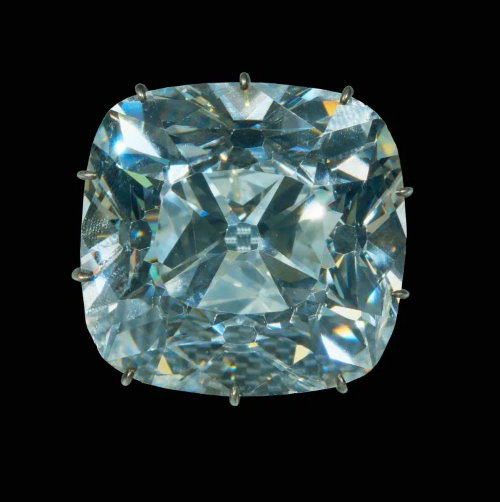
Le Régent diamond
Crown of Impress Eugénie
Shortly after his marriage to Eugénie, Napoléon III ordered a new set of pearls and diamonds for her, comprising a tiara, a crown and a large corsage brooch, which were executed by Lemonnier, and two shoulder brooches and two bodice pins, which were the work of jeweler Kramer. The pearls and diamonds came from a set created by Nitot for Marie-Louise from 1810 to 1812, and modified in 1819-1820. Lemonnier's diadem is visible in the famous portrait of Eugénie by Winterhalter. When the Crown diamonds were sold in 1887, the tiara was awarded to the jeweler Jacoby and luckily was not cut up; it was acquired in 1890 by Albert de Tour-et-Taxis, on the occasion of his marriage.
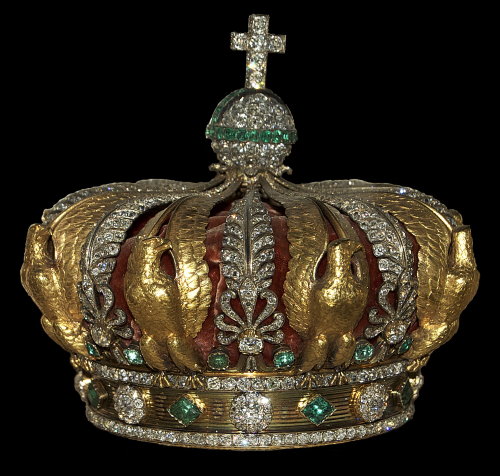
Crown of Empress Eugénie
Stay in top Paris hotel with indoor pool

Hotel near Louvre Museum
Located 300 m from the Louvre Museum and 500 m from Les Halles Shopping Mall, L'Empire offers air-conditioned rooms with satellite TV and free WiFi. The wellness area offers a hammam, sauna and treatment rooms. The Cafe serves a buffet breakfast and a variety of French cuisine for lunch and dinner. Best hotels near Louvre Museum.
Paris 75001 France

Hotel Empire is located near Louvre Museum
French Crown Jewels history. What happened to the French Crown Jewels?
The Crown Jewels collection was deliberately formed in 1530 by king François Ier who isolated a small group of eight stones or jewelry in his possession and declared them inalienable. This first collection, of which only the ruby known as the Côte-de-Bretagne remains, was considerably increased thereafter, particularly by Louis XIV. The stones were sometimes pledged but were always recovered. The treasure was lessened by the famous theft which took place in the week of September 11 to 17, 1792, at the Hôtel du Garde-Meuble de la Couronne, in Paris, where it was kept. But it was again increased under Napoléon, so that it included, in 1814, 65,072 stones and pearls, most of them mounted in jewelry, that is 57,771 diamonds, 5,630 pearls and 1,671 colored stones (424 rubies, 66 sapphires, 272 emeralds, 235 amethysts, 547 turquoise, 24 cameos, 14 opals, 89 topaz). Sheltered during the 1870 War, the Crown Jewels were successfully exhibited in Paris in 1878, on the occasion of the Universal Exhibition, then in 1884, at the Louvre, in the Salle des Etats.
But already they were threatened, not out of greed but out of hatred for the monarchy. The still fragile Republic wanted to forever deprive the pretenders of the possibility of using the Crown Jewels. The latter’s most effective adversary was Benjamin Raspail, a member of parliament. He tabled in the House in 1878 a motion calling for the sale, which was approved in June 1882 only, by 342 votes to 85. In the same year 1882, a commission of experts was appointed to prepare the sale; it happily proposed and succeeded in saving a few stones and pearls which were attributed to the Louvre (the Regent, the Côte-de-Bretagne), the Museum of Natural History and Ecole des Mines. After discussions in the Senate, the alienation law, adopted in December 1886, was published in the Official Journal on January 11, 1887, being signed by Jules Grévy, President of the Republic, and by Sadi Carnot, Minister of Finance: "Diamonds , precious stones and jewels belonging to the so-called Crown Jewels collection (…) will be sold at public auction. The proceeds of this sale will be converted into government annuities. "
At that time, the collection, rich in 77,486 stones and pearls, included two groups of jewels: the first, the oldest, dating from the Restoration and the second executed under the Second Empire, the Crown Diamonds not having been used under the July monarchy. During the Restoration, Louis XVIII brought up for his nieces, the Duchess of Angoulême and the Duchess of Berry, the adornments executed for Marie-Louise: thus the sale of 1887 included the adornment of rubies and diamonds, the adornment of sapphires and diamonds, the set of turquoises and diamonds and the diadem of emeralds and diamonds executed for these princesses, who had also served for the Empress Eugénie. As for the jewelry made during the Second Empire, it was bursting with opulence and imagination. It was in particular on the occasion of the Universal Exhibition of 1855 that Napoléon III had the greatest Parisian jewelers make magnificent jewels: a crown for him, whose mount was broken and melted at the time of the sale, a crown for the Empress, sumptuous jewelry for the latter, in particular a diamond belt knot ending in two tassels and a set of diamond currant leaves, comprising a garland serving as a necklace, a corsage and a front bodice. Other admirable works were created in the following years, such as the diamond tassel comb (1856), the Russian diadem (1864), the Greek diadem (1867). We could have had everything again.
The sale took place in the Louvre in nine vacations, from May 12 to 23, 1887. It was a financial failure. The appearance on the market of such a quantity of stones could only depreciate them. The historical provenance of the pieces, so important commercially today, was not taken into account. The collection sold was estimated at 8,000,000 F. or approximately. It was priced at 6,000,000 F. The State having spent 293,851 F. to organize the sale, the effective revenue only increased to 6,927,509 F. Disappointing financially, the sale was disastrous on the historical level, on the mineralogical level, given the quality of certain stones that we no longer find now, and on the artistic level, so many masterpieces of French jewelry disappearing at the same time. Because everything contributed to making the stones lose their identity: to facilitate purchases, the elements of the ornaments of the Restoration were sold separately, the decorations of Napoléon III were dismantled, the adornment of currant leaves was scattered. The buyers were mainly jewelers (Boucheron, Bapst Frères, Tiffany, etc.), who cut up most of the jewels to reuse the stones.
Louvre map and visit
The Louvre is extremely large. A Louvre guided tour is therefore practical to get quickly to the museum's top masterpieces. If you want to visit the Museum on your own, use the Louvre interactive map to prepare your visit.
Virtual tour of Louvre Museum
Download official Louvre map PDF and guide with floor plan
From the main entrance through the pyramid, access the Carrousel du Louvre Paris Shopping Mall, a complement to your visit. The Tuileries Gardens close by are one of Paris best parks. A reason to book a hotel near Louvre Museum.
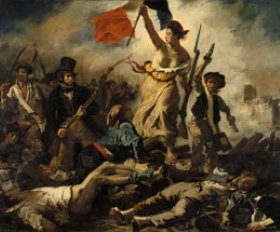
Liberty leading the people - Delacroix
Louvre Museum hours
The Louvre is open 9am to 6pm on Monday, Thursday, Saturday and Sunday. It is open from 9am to 9pm on Wenesday and Friday.
The museum is closed on Tuesday, January 1, May 1, November 11, December 25. Rooms begin closing 30 minutes before closing time.
Louvre Museum tickets
Louvre Museum ticket price is 22 euros. Access is free for everyone on the first Friday of the month after 6pm, except July and August, and on July 14. Reservation is required. Buy Museum tickets.
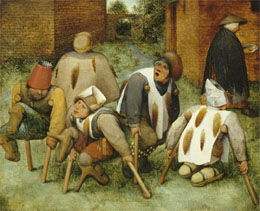
Beggars - Bruegel
Louvre Museum address
Locate Louvre Museum on Paris map
Paris metro: station Palais Royal on line 1
The famous glass pyramid (Paris map) designed by architect I.M. Pei is the main entrance to the Louvre Museum. To avoid the long pyramid queue, enter through Carrousel du Louvre entrance (Paris map), 99 rue de Rivoli.

Eros and Psyche - Canova - Italy